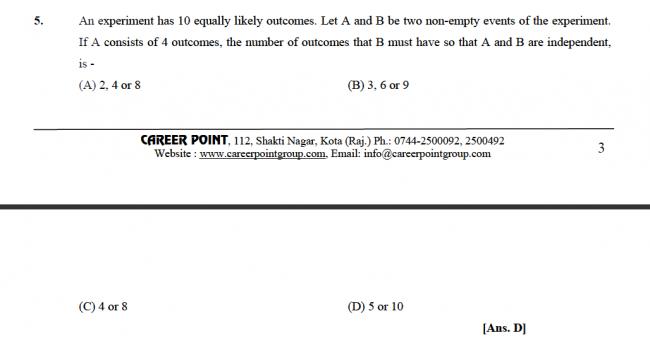pl. tell me if is this crrct : for independent events : P(A∩B)=P(A).P(B)
15 Answers
P(A)=4/10
P(B) = x/10
P(A∩B) = 4x/100
now 4x/10 is an integer!
so x=0 or 5 or 10 or ... 25
now also see P(B) <= 1 so x=5 or 10 are only possible
so P(B) = 5/10 or 1
luk, for 2 events to be mutually independent, P(A/B) = P(A)..
here let us assume that the second even has a total event space of x+y elements, x of which lie in intersection with the first set, and y of which donot lie in intersection with the first set...
now as said, P(A/B)=P(A)
or P(A∩B)/P(B)=P(A) we have P(A∩B)=x/10, P(B)=4/10, and P(A)=(x+y)/10
substuting we have ,[x/10]=[4/10]*[(x+y)/10]
thus we have 3x=2y...
now we know that x can be anything in {1,2,3,4}
so corresponding y can be {1.5,3,4.5,6}
and as we are looking for integral values of y we have y={3,6} for x={2,4}
thus n(A)=x+y ={5,10}
thus D)
cheers!!
because the intersection of the two has to be an integer...
because it is from 10 objects
so the intersection will have an integer number of objects
the probability of which is n(A∩B)/10 = n(A).n(B)/100
hence n(A∩B)= n(A).n(B)/10 = 4x/10
which is an integer
gordo your method is right.. but i think you could just make the thinking more simple...
becoz of the simple reason subash that i can have only integral number of out comes of a certain event, i mean i cannot have my event space as 2.5, 1.5 or sumthing, i can have it as integers...
sir my method cud be lengthy, yeah, but is wat i cud put on paper when i saw the Q.
yes gordo.. it is not a bad method by any means.. but i commented only because i thought that it is a bit complicated method of something which is just a bit simpler..
2. Let two non-collinear unit vectors aˆ and bˆ form an acute angle. A point P moves so that at any time t the
position vector
→
OP (where O is the origin) is given by aˆ cos t + bˆ sin t. When P is farthest from origin
O, let M be the length of
→
OP and uˆ be the unit vector along
→
OP . Then
FIND vector u
*** pnote : ^ denotes unit vector
mod(P)=root(/a/2+/b/2+2/a//b/cos∂) =root(1+2cos∂costsint) =root(1+cos∂sin2t) clearly this is maximum when sin2t=1 or t=pi/4.. so u have maxmod P=root(1+2cos∂) =root(1+2a.b) now unit vector along maxPlies on the bisector of the angle btween a and b so V=a+b/mod(a+b) cheers!!
OH K.......
BTW this is a property or wat??
unit vector along maxPlies on the bisector of the angle btween a and b
nahi yaar..luk...for maxP, in this case that is, we have /a/=/b/=1/√2
now if two vectors have equal magnitude, the resultant wud be in the direction of the angle bisector, one cud make this out by common sense or by the gud ol' parallelogram rule...
